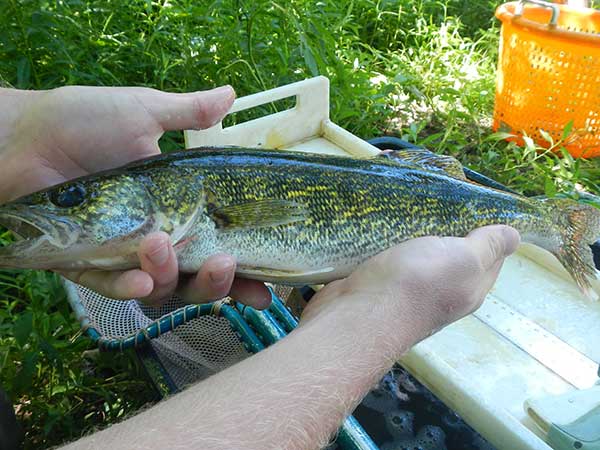By Louie Stout
 />Biologist says first-ever walleye stocking in Elkhart River doing great.An experimental walleye stocking by the Elkhart River Restoration Association (ERRA) is paying off.
/>Biologist says first-ever walleye stocking in Elkhart River doing great.An experimental walleye stocking by the Elkhart River Restoration Association (ERRA) is paying off.
St. Joseph River biologist Daragh Deegan, who conducts river studies for Elkhart and South Bend, said this summers on-the-water work has shown remarkable success from the initial stocking two years ago.
In the fall of 2012, the association purchased about 3,200 6- to 8-inch walleyes from a Wisconsin fish farm and released them into the Elkhart River.
Deegans surveys this summer not only have unveiled quite a few walleyes, but several over the legal length of 15 inches and a few were pushing 17 inches.
Thats pretty phenomenal growth over a short period, he said. And, were getting a lot of reports from anglers who are catching nice walleyes from the Elkhart.
The association is hoping for similar results when they plant an additional 2,000 next month. The non-profit group pays for the stocking through fundraisers it conducts throughout the year, including its annual rain barrel auction. They also received a solid contribution from the Nappanee Conservation Club.
Deegan expects the fish to continue to do well.
The Elkhart has pretty good habitat and abundant forage, Deegan said. The walleyes primarily eat minnows.
The fish are purchased from the same fish farm that the Indiana DNR and the Michiana Walleye Association obtain their walleyes for the St. Joseph River stocking which has proven to be equally successful over the past several years.
The St. Joseph is stocked every two years, including last fall. The Elkhart is stocked in alternate years.
Theres a dam on the Elkhart about a half mile upstream from its confluence with the St. Joe. About 2,000 fish will be stocked between Elkhart and Goshen with 1,250 going above another dam in Goshen.
While Deegan acknowledges some of the Elkhart fish escape the Elkhart into the St. Joe, his findings have proved that many stay home.
With the tagging program weve seen in the St. Joe, we estimate about 10 percent of the fish stocked above the Twin Branch Dam spill into lower sections of the river, so we can assume we have some that do the same on the dams on the Elkhart River, too, he explained.
The Elkhart River is best suited for shallow draft boats like jet drive jon rigs, kayaks or canoes. Its equally popular among wading anglers.
Theres good boating access above the Goshen dam at Rogers Park. Access sites along the Elkhart can be found on the ERRA website, www.elkhartriverrestorationassociation.org.
I like to wade for walleyes and smallmouth on the Elkhart in my free time, noted Deegan. There are a few holes that you have to get around, but those holes are good places to find the walleye.
The Elkhart has an abundant smallmouth bass population, too, but they dont grow as fast as they do in the St. Joe.
A 12-inch smallmouth on the Elkhart is 5-6 years old where as it might only be 3 to 4 years old in the St. Joe, said Deegan. It could be a genetics thing or a water quality issue since the Elkhart does have quite a bit of sediment and will get muddy. But there are quite a few of smallmouth and they make it fun with a light rod while wading.
The walleyes cost the ERRA about $2 each and the group is looking for additional donations from clubs or individuals to sustain the program. Its a solid investment in the future; you can find out how to help at the clubs website, www.elkhartriverrestorationassociation.org.